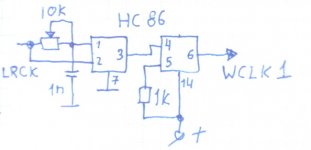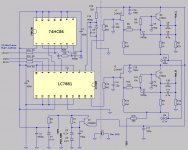I just discovered an ancient Sanyo LC7881 DAC in an older cd player and I am enjoying the sound very much; it has the sweet fluidity of TDA1543 combined with great details
That's a useful tip-off, thanks. I'll order up some from Taobao and have a play - at least from the diagram of the internals in the DS there aren't any opamps inside.
I haven't found any service manual of this old player, but I'm wondering if you guys would take a look at these other implementations I attached to see and maybe give some advice if I could force this DAC to NOS mode thus eliminating the digital filter; the first 2 images are from a NAD 5325 , the 3-rd is from a sansui cdx-301i and the 4-th is from a pioneer pd-m500, thanks
I had a quick look at the schematics - the best bet for going NOS with the LC7881 looks to be the NAD. That is the only one which has a recognisable and distinct oversampling filter chip (YM3404) which almost certainly can be bypassed. It shouldn't be removed though as its being used as a clock generator too.
may I ask what kind of signal will you feed it with as an external dac configuration? as I see the datasheet it only accept sony/eiaj format in 48bit frame ; these modern USB converters output only I2S so would need some glue logic for conversion, and as I read on some forums even then would be tricky because this LC7881 has some proprietary input format expecting also some kind of MCLCK on it's input;
collected some info from russian forums using google translate
"Unfortunately, 7881 and 9001 will not be able to marry directly. The input WCLK1 must be fed with twice the sampling rate, i.e. F (WCLK) = 2f (LRCK). DIRKA does not produce such a signal. To hear the whole charm of this really good DAC, it's better not to use SPDIF at all, but to connect it directly to the signal processor, which has all the necessary signals. For example: CXD2500 (used in Pioneers, TEAC VRDS) or MN6626 (in Technicas). The latter is less preferable.
To the standard I2S LC bus, you can still connect. Method 1d - on 74ns86 to collect the frequency doubler LRCK, then by datasheet. Method 2d - LC7881 is converted to monocapture mode, by chip per channel, by shift register we get data for the second channel. I did so and so, both ways - not for the first project."
"About the second method a little more. In the process of amusing pleasures with 7881, I discovered an "undocumented feature" . We feed log1 to the LRCK input, the LRCK signal to the WCLK1 input, and from the 20th leg we take the signal of the channel, which is the first channel on the datasheet, the silence on the 1st leg ... Ie. We get a standard mono-DAT that outputs data on the LRCK yield (well, straight LE). If very accurate, a few beetles later. By the way, with the interrupted tact this shnyaga does not work.
Another moments. Repeatedly, Semigor in particular, about the importance of nutrition 7881. I have so - legs 2 and 3 short-circuit and power from REF02, on the 4th and 10th leg - according to TL431, well, the primary stubs"
I attached a working diagram of doubling the LRCK for the MCLCK using 74ns86 for NOS mode and a possible feeding of I2S (right justified) signal using this same chip
collected some info from russian forums using google translate
"Unfortunately, 7881 and 9001 will not be able to marry directly. The input WCLK1 must be fed with twice the sampling rate, i.e. F (WCLK) = 2f (LRCK). DIRKA does not produce such a signal. To hear the whole charm of this really good DAC, it's better not to use SPDIF at all, but to connect it directly to the signal processor, which has all the necessary signals. For example: CXD2500 (used in Pioneers, TEAC VRDS) or MN6626 (in Technicas). The latter is less preferable.
To the standard I2S LC bus, you can still connect. Method 1d - on 74ns86 to collect the frequency doubler LRCK, then by datasheet. Method 2d - LC7881 is converted to monocapture mode, by chip per channel, by shift register we get data for the second channel. I did so and so, both ways - not for the first project."
"About the second method a little more. In the process of amusing pleasures with 7881, I discovered an "undocumented feature" . We feed log1 to the LRCK input, the LRCK signal to the WCLK1 input, and from the 20th leg we take the signal of the channel, which is the first channel on the datasheet, the silence on the 1st leg ... Ie. We get a standard mono-DAT that outputs data on the LRCK yield (well, straight LE). If very accurate, a few beetles later. By the way, with the interrupted tact this shnyaga does not work.
Another moments. Repeatedly, Semigor in particular, about the importance of nutrition 7881. I have so - legs 2 and 3 short-circuit and power from REF02, on the 4th and 10th leg - according to TL431, well, the primary stubs"
I attached a working diagram of doubling the LRCK for the MCLCK using 74ns86 for NOS mode and a possible feeding of I2S (right justified) signal using this same chip
Attachments
Last edited:
- Status
- This old topic is closed. If you want to reopen this topic, contact a moderator using the "Report Post" button.

